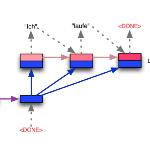Recently, sequence-to-sequence (seq2seq) models with the Transformer architecture have achieved remarkable performance on various conditional text generation tasks, such as machine translation. However, most of them are trained with teacher forcing with the ground truth label given at each time step, without being exposed to incorrectly generated tokens during training, which hurts its generalization to unseen inputs, that is known as the "exposure bias" problem. In this work, we propose to mitigate the conditional text generation problem by contrasting positive pairs with negative pairs, such that the model is exposed to various valid or incorrect perturbations of the inputs, for improved generalization. However, training the model with naive contrastive learning framework using random non-target sequences as negative examples is suboptimal, since they are easily distinguishable from the correct output, especially so with models pretrained with large text corpora. Also, generating positive examples requires domain-specific augmentation heuristics which may not generalize over diverse domains. To tackle this problem, we propose a principled method to generate positive and negative samples for contrastive learning of seq2seq models. Specifically, we generate negative examples by adding small perturbations to the input sequence to minimize its conditional likelihood, and positive examples by adding large perturbations while enforcing it to have a high conditional likelihood. Such "hard" positive and negative pairs generated using our method guides the model to better distinguish correct outputs from incorrect ones. We empirically show that our proposed method significantly improves the generalization of the seq2seq on three text generation tasks - machine translation, text summarization, and question generation.
翻译:最近,与变换器结构的序列到序列模型(seq2seq)在各种有条件的文本生成任务(如机器翻译)上取得了显著的成绩。然而,大多数模型都经过教师的训练,在每次步骤中都使用地面真实标签,而没有暴露在训练过程中错误生成的标牌上,这伤害了它被称作“暴露偏差”的无形投入。在这项工作中,我们提议通过将正对正对对对面与负对面对比来缓解有条件文本生成问题,例如,该模型暴露在投入的各种有效或不正确的扰动中,以便改进一般化。然而,大多数模型是用随机的非目标序列作为负面实例,用天性对比性对比性学习框架来培训模型,因为培训过程很容易与正确输出区分,特别是模型先于大文本的“暴露偏差偏差偏差”问题。此外,产生正面实例需要具体领域增强超常的超常。为了解决这个问题,我们提出了一种有原则的方法,即产生正反的模型,用来产生正反比和反偏差的模型,用以进行更精确的反向的反向学习后进和反正2等模型。 具体地,我们用一个反的模型来产生一个反向的模型,用一个反向的模型,用反推式的模型,我们生成的模型来产生反向的模型,用一个反向正的模型的模型的模型,用一个反推的模型,用一个反推的模型,用一个反推的模型,用一个反推的模型,用一个反推的模型,用一个反推的模型,用一个反推的模型,用一个反法的模型,用一个反法的模型,用一个反推的模型,用一个反法的推的模型,用一个反推一个反推一个反法的模型,用一个反法的推的推的推的模型,用一个反法,用一个反法的推。




